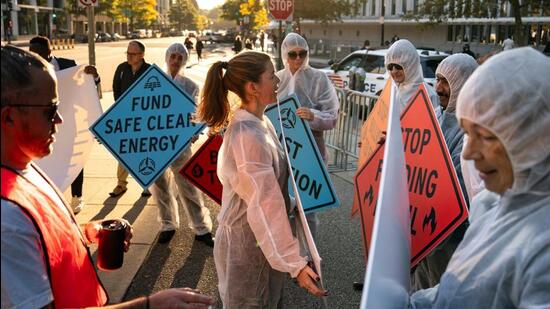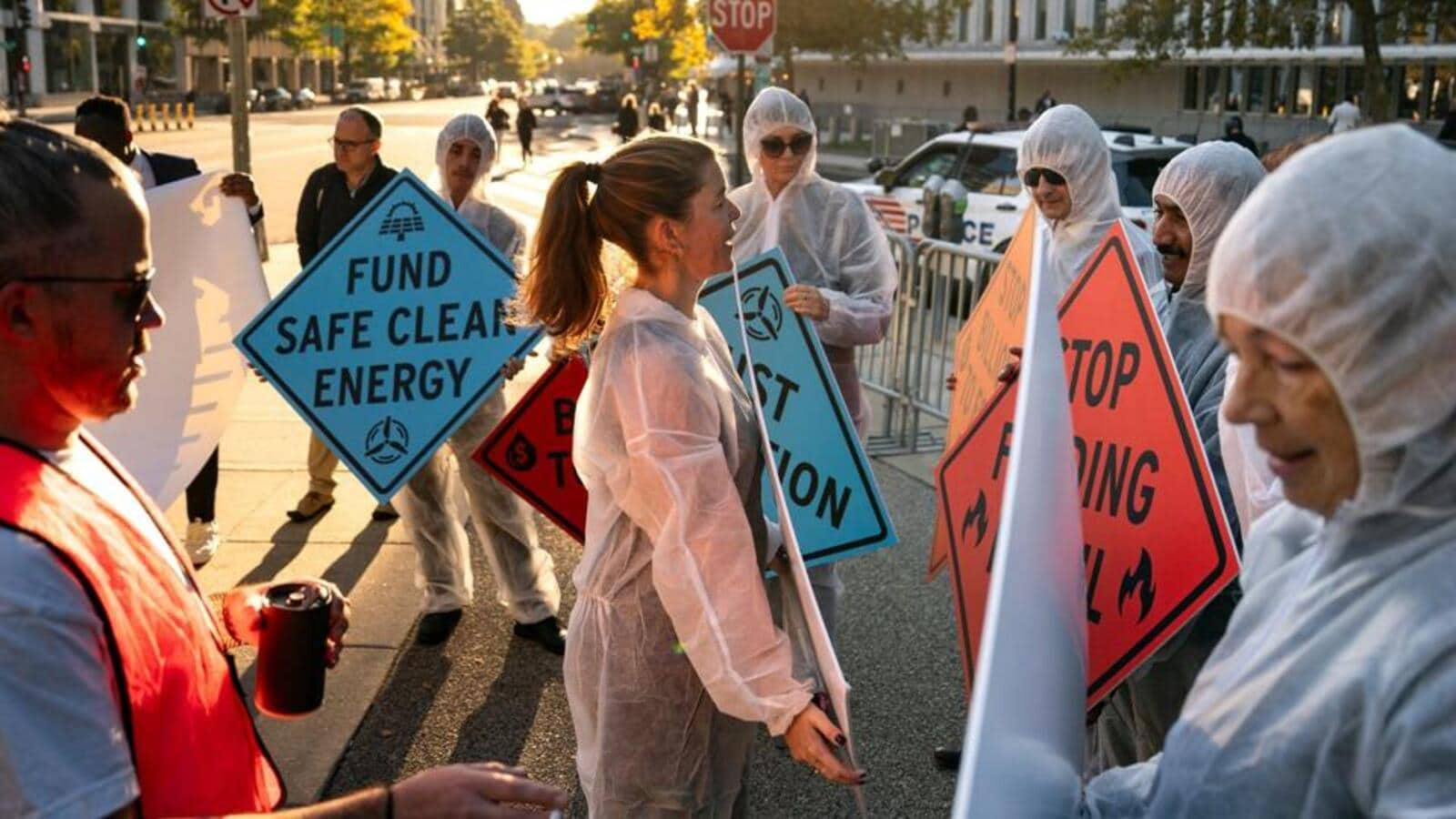The issue of who, or which countries, will pay for climate change mitigation during this critical decade is still a matter of intense debate. Finding an area of consensus on that is expected to be key in whether or not there is a climate deal in Baku. Here’s why.
 Climate activists protest against in Washington, DC, on October 21. (Bloomberg Photo)
Climate activists protest against in Washington, DC, on October 21. (Bloomberg Photo)
The Council of the European Union on October 14 agreed on its official negotiating position ahead of the UN Climate Conference (COP29) in Baku. The document, available on the Council’s website, states that the need for expanding the group of contributors is a prerequisite for an ambitious NCQG.
New Collective Quantitative Goal or NCQG is a new financial target to support developing countries in their climate actions post-2025. This target is meant to build on the floor of $100 billion a year, set in 2009 (a funding target the developed world met only in 2022).
The Council of EU says its position is based on the evolution of respective economic capabilities and increasing shares of global greenhouse gas emissions since the early 1990s, and their dynamic nature.
This is among several other priorities listed by the Council of EU which has called for an “ambitious and balanced” outcome in Baku that (i) keeps the 1.5 degrees C temperature goal within reach, in light of the best available science (ii) moves us all forward towards a long-term resilience, and (iii) agrees an effective, achievable and ambitious NCQG.
Based on the Council of EU’s position, analysts say Baku will likely see a stronger push to include China, UAE and Saudi Arabia , and perhaps even India in the list of contributors.
They point out that the EU’s stance obliterates pre-1990 period and historical responsibility.
“The US has an even more hardline stance. They have put no quantum on the table and have in the past repeated that contribution to NCQG is voluntary and for those who choose to pay. Further, the US position will depend a lot on the US Presidential elections that coincide with COP29,” said an analyst who asked not to be named.
EU has also stressed that all contributors report the amount of climate finance provided and mobilised to improve transparency and enable stronger coordination.
“We should refocus discussions on the responsibilities of developed countries as outlined in the legal agreements, particularly their obligation to provide and mobilize climate finance for all developing countries. This is not up for debate; the emphasis must be on the quantum of finance required, rather than the identity of contributors. US has an even more hardline stance. They have put no quantum on the table and have in the past repeated that contribution to NCQG is voluntary and for those who choose to pay. Further, the US position will depend a lot on US Presidential elections that coincide with COP29,” said Diego Pacheco, lead negotiator for Bolivia and spokesperson of the grouping called Like-Minded Developing Countries.
“Wealthy nations, whose prosperity was built on over 150 years of fossil-fuelled industrialization, cannot simply start counting the emissions from the 1990s. They bear a historical responsibility for driving climate change, and it’s time they acknowledge that debt. Climate finance for developing nations is not charity or business investments—it’s a matter of reparations. The burden of this crisis should not be shifted onto those barely responsible for causing it,” said Harjeet Singh, Climate Activist and Global Engagement Director for the Fossil Fuel Non-Proliferation Treaty Initiative responding to EU’s position.
HT reported on October 17 that a new document– a report on the progress on matters related to the new collective quantified goal on climate finance released by United Nations Framework Convention on Climate Change shows certain countries have suggested a very vast range for the quantum of the fund. For example, on the quantum of the NCQG, parties discussed options such as an annual goal of $1 billion, $1.1 billion, $1.3 billion or $2 trillion, or setting the goal from a floor of $100 billion per year.
On the mitigation aspect, EU has laid a lot of emphasis on the 1.5 degrees Celsius goal of the Paris Agreement. It has urged all Parties to follow up and reflect global efforts agreed in the global stocktake decision (at COP28, UAE) through scaling up of NDCs (nationally determined contributions; essentially emission reduction targets) to be submitted well ahead of COP30 (to be held in Brazil), in line with the Paris Agreement.
Another issue that may meet resistance during negotiations is the push to phase out coal. Developing countries such as India continue to be heavily reliant on coal while pursuing transition to renewable and low carbon energy options. EU in its negotiating document has stressed that the energy sector should be predominantly free of fossil fuels well ahead of 2050, and the importance of aiming to achieve a fully or predominantly decarbonised global power system in the 2030s, leaving no room for new coal power.
A discussion, earlier this month, held under Chatham House rules, titled ‘The Road Ahead: Building on Global South Strengths at COP29 and G20’ and organised by Climate Trends saw discussions on the finance negotiations likely at COP29 by economists who have served in senior positions in the government.
One of the economists attending the discussion said it’s important that India manages to change the narrative on proportion of responsibilities of countries based on historical responsibility.
Another economist, a former senior official from India’s erstwhile Planning Commission had said India needs a more nuanced position. “ How do we distribute the carbon budget? One simple way is based on population. But that may not be accepted because India and China will stand out. Honestly, we have not proposed a way of doing it.”
